As of this year, I've managed to camp exactly two nights, and one of them was at this lovely, nearly deserted state park no more than half an hour north of my conference at the Galt hotel in downtown Louisville. I should note, Charlestown State Park (just outside Charlestown) is in Indiana, not Kentucky. I basically had the loop of campgrounds I stayed in to myself, so it didn't matter that they were exposed improved camping with few trees to divide them from each other and shelter us from the “streetlights”. I positioned the wizard's brand new one-person tent under a little sapling and reveled in the night sounds, though it was so incredibly hot I wished I'd ignored the rangers’ predictions of rain and left the fly off.
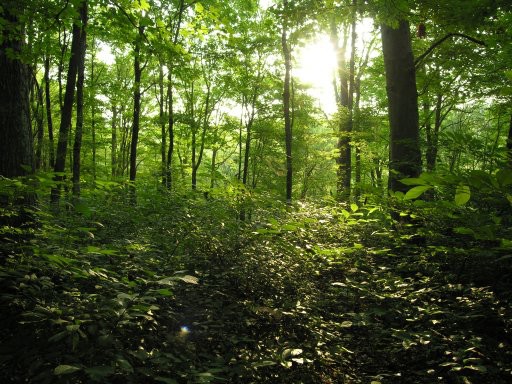
It's always easier to write about the difficulties hiking and camping—all too difficult to describe the sublime beauty of the woods without sounding mawkish, and even photographs never do more than touch upon the deep-woods light of an early morning.
There were wonderful night sounds—crickets, and what a woman who had these same animals singing outsider her house that I visited lately thought were frogs—not spring peepers, as she suggested (I know what those sound like) but some sort of amphibian. I think. (I was at yet a different get-together when we had to go around asking questions on a slip of paper to each other. Mine was ‘Do you consider yourself an indoor or outdoor type?’ which I thought was pretty stupid, ’cuz Americans—unless they're park rangers, or landscapers, [male] Amish or construction workers and the like [also usually male]—pretty much spend their time indoors. As a result most of us cannot reliably identify 10 native flowers to our regions, but 300+ corporate logos is no problem.) So I can't swear these were frogs, more shame on me.
Some folks do not like these sounds of summer, but I adore them (though I admit I'm glad we don't have the Vietnamese variety of cicada that's so loud you'd probably get hearing loss if they set up next to your house...) I even like natural human type summer sounds, like kids shrieking as they play—it's the lawnmower, leaf blower, and automobile engine noise I can't stand. (Though I will admit, tracking the sounds of the highway is probably the most reliable method I've found for orienting oneself in the woods without a compass or GPS.)
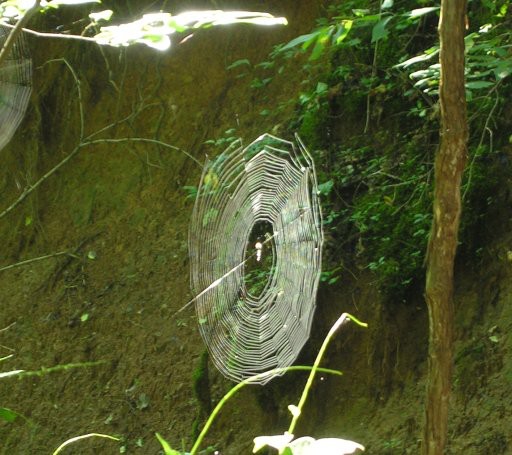
This is one of the few orb web pictures taken in enough light to be more or less in focus. There literally hundreds of these webs strung across the path of trail #1, which evidently hadn't been hiked for several days.
The next morning I decided to go hiking on trail one, on the theory that I would be probably be running late and that much closer to the park entrance and my eventual destination when I finished. The trail was about 2.2 miles long and rated “rugged”, which so far as I could tell meant you had to watch out for tree roots and do a bit of climbing occasionally—there was a very short section where I was breathing hard, but anyone in moderate condition would have no difficulties; likewise I certainly wouldn't’ve objected to my hiking boots had they magically appeared on my feet, but I got by fine in tennis shoes. I certainly didn't need a walking stick, and I was sorry I didn't bring my monopod, because either would've been handy for batting away the many, many, many spider webs built across the trail. The orb webs were certainly beautiful, and because I failed to bring said tripod, I didn't really do them justice. But they surely kept the mosquitoes down. I didn't see any.
There were also, as I mentioned previously, a great many ticks. The ranger I spoke to said they had deer, turkey and wood ticks, (I saw deer at the park) and as it happens the tick I combed out of my hair was an ‘American Dog Tick’. These do not carry lyme disease—in fact my doctor called the CDC and discovered that even though people in the region occasionally suffer flu-like symptoms, there's no lyme disease there. Nor rocky mountain spotted fever, which is apparently what american dog ticks carry. Since I find tick bites do not itch, I stopped worrying about them.
But I'm really glad I wore long pants and long sleeves, and wished the flap of my hat extended down further (I forgot it entirely the first day, since I normally wear it for shade, not spiderweb and tick protection.)
There was a list of trees to look for, but I really only remember the many maples; shagbark hickory (easy to identify); and alianthus (the infamous trees of heaven). I saw some with pointed compound leaves like ash or black walnut—come to think of it, there had to be some of the latter, ’cuz I saw the nuts. Oh, and slippery elm, which has very fuzzy, distinctive feeling leaves. So, sorry, I can't really say what kind of a forest this was.
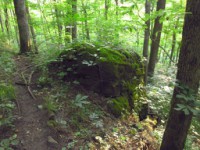
I felt that trail nos. 1 and 2 were the most beautiful, ’cuz I'm such a sucker for mossy rocks, and ferns. Trail number 2 has the additional bonus of only being about a mile long and moderate—good for folks in a hurry. But sights like this made trail number 1 my fave. 3 and 4 followed a side-branch of the river ‘fourteenmile creek’ (as I recall) more closely—geared to fishermen, I think.
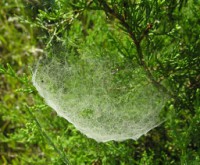
After spending the night at the state park, and doing my pre-conference workshop the following day (Weds) I had Thursday off, so I returned to the park to do more hiking. Knowing I'd have a difficult time photographing the orb webs in the deep woods, I took this picture to commemorate all the spiders.
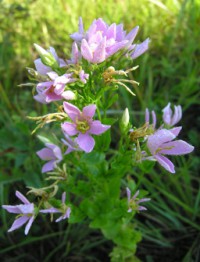
I never seem to go anywhere without taking at least one flower picture, and here's the one for this trip...:) A bit of explanation: the park has 4 hiking trails, #1 at the entrance (rugged 2.2mi), #2 midway near picnic area (moderate 1 mi), and #3 and #4 at the rear, at 1.8 and 2.5 miles respectively. I did #1 Wednesday morning before my workshop, then returned Thursday, and started with #4, then did #2, and finished up with #1 again.
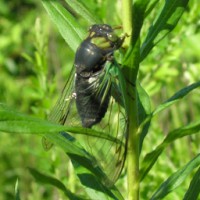
This cicada, taken at the trailhead of #4, obligingly stayed put while I tried to capture the source of the sound I think of as ‘hot summer days’. (When I was a child, I thought there was a factory nearby, making the noise—I didn't realize it came from insects!)
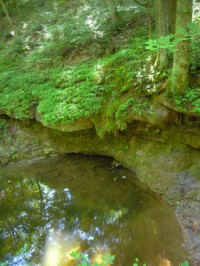
This pool, taken in trail no. 2, was, like the mossy rock one that started the thumbnail series, fairly extensively gimped—at least for me—and I did basically the same thing to both images. The first step is always to crop the image if desired, to reduce the load on the RAM as I work on the image. Because the camera's white balance had difficulty coping with the light no matter how I set it (not that I tried that hard) I started by darkening the burned out highlights of the sun on leaves (though to be fair, they burn out in my eyeballs, too...) that result from being unable to handle that wide a value range, then punched up the color saturation to compensate for the washed out quality that comes from darkening the highlights. Then I started playing with the mid-tone chromatic values, increasing the blue by +38 value, the red by +10 or so and decreasing the green by -5 or 10. At this point the dirt looked pretty much the way I remembered the color, so then I scaled down and finished up (renaming file/moving it to web-directory, adding copyright/original file info, etc).
And for all you for whom arachnids don't fascinate, I have some pretty butterflies that I separated out of the main Charlestown state post for next time.
file created 05aug05
Unless otherwise noted, text, image and objects depicted therein copyright 1996--present sylvus tarn.
Sylvus Tarn